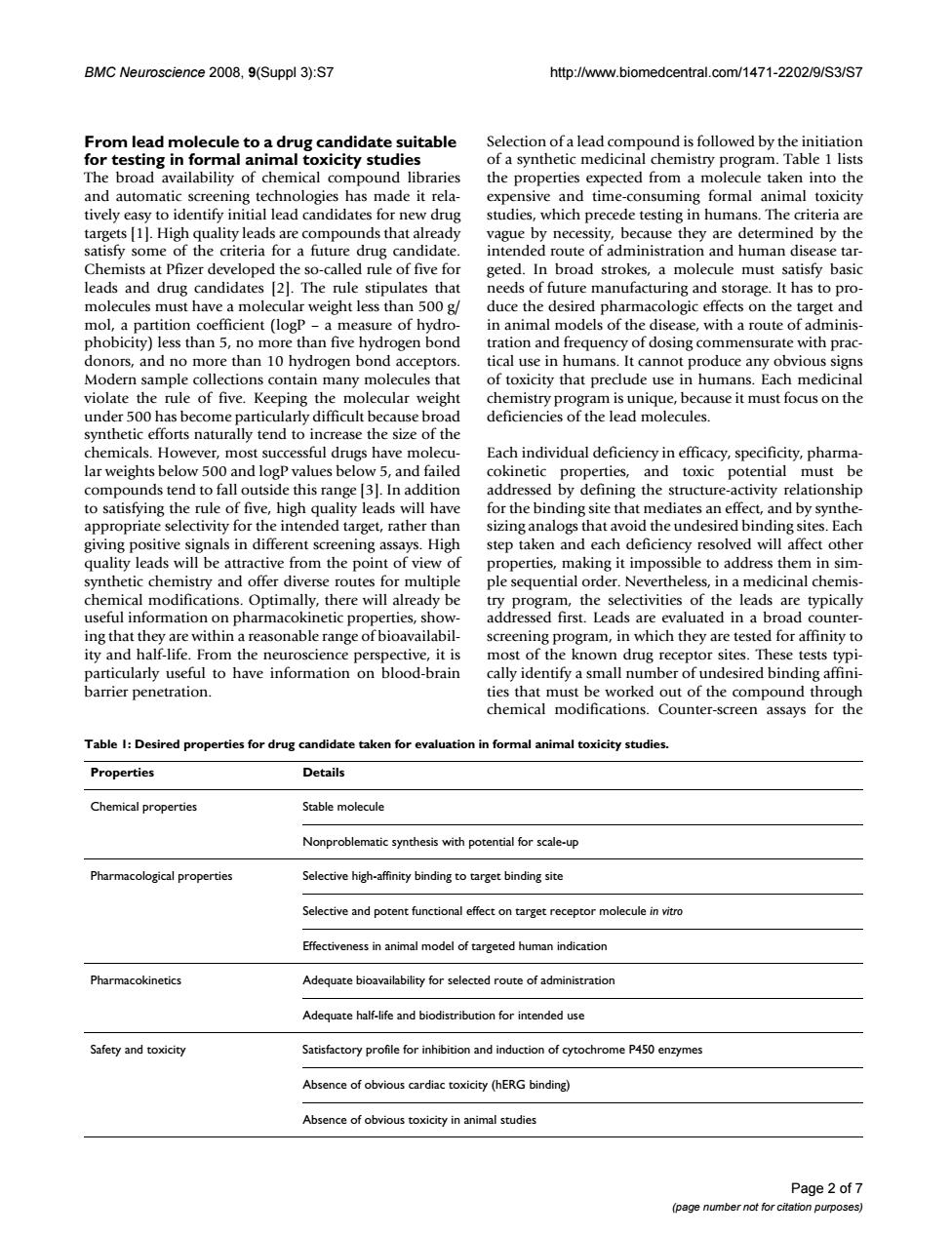正在加载图片...

BMC.9(Suppl 3):S7 http://www.biomedcentral.com/1471-2202/9/S3/S7 ndidate suitable Selection ofa lead c The broad libraries the properties expected from a molecule taken into the and tim targets 1.High quality leads are compounds that alre cause they are determined by the and human tisfy ba The inulat of fu molecules must have a molecular weight less than 500 g/ duce the desired pharmacologic effects on the target and n animal models of the se se,with a route of a minis d n ore than 10 hydr nd e ical n hu Modemn sample collections contain many of toxicity that predlude use in humans.Each medicina the chemicals.However,most successful drugs have molecu Each individual deficiency in efficacy,specificity,pharma- lar weights below 500 P values belo 5,and fai d prope potentia must le of fv hind nthat avoid the undesired binding step taken and each chem and offer chemical modifications.Optimally,there will already be progran the selectivities of the leads are typically useful information on pharmace eevaluated in a br ity and hall-life From the ne ctive it is st of the known drug r particularly useful to have information on blood-brain cally identify a small number of undesired binding affini barrier penetration on Table Desired properties for drug candidate taken for evaluation in formal animal toxicity studies. Properties Details Sable molecule Nonproblematic synthesis with potential for scale-up olgical properties binding binding Selective and potent Effec ess in animal model of targeted human indication Pharmacokinetics Adequate half-life and biodistribution for intended use Safety and toxicity Satisfactory profile for inhibition and induction of cytochrome P450 enzymes Absence of obvious cardiac toxicity (hERG binding) Page 2 of7 (page number not for citation purposes) BMC Neuroscience 2008, 9(Suppl 3):S7 http://www.biomedcentral.com/1471-2202/9/S3/S7 Page 2 of 7 (page number not for citation purposes) From lead molecule to a drug candidate suitable for testing in formal animal toxicity studies The broad availability of chemical compound libraries and automatic screening technologies has made it relatively easy to identify initial lead candidates for new drug targets [1]. High quality leads are compounds that already satisfy some of the criteria for a future drug candidate. Chemists at Pfizer developed the so-called rule of five for leads and drug candidates [2]. The rule stipulates that molecules must have a molecular weight less than 500 g/ mol, a partition coefficient (logP – a measure of hydrophobicity) less than 5, no more than five hydrogen bond donors, and no more than 10 hydrogen bond acceptors. Modern sample collections contain many molecules that violate the rule of five. Keeping the molecular weight under 500 has become particularly difficult because broad synthetic efforts naturally tend to increase the size of the chemicals. However, most successful drugs have molecular weights below 500 and logP values below 5, and failed compounds tend to fall outside this range [3]. In addition to satisfying the rule of five, high quality leads will have appropriate selectivity for the intended target, rather than giving positive signals in different screening assays. High quality leads will be attractive from the point of view of synthetic chemistry and offer diverse routes for multiple chemical modifications. Optimally, there will already be useful information on pharmacokinetic properties, showing that they are within a reasonable range of bioavailability and half-life. From the neuroscience perspective, it is particularly useful to have information on blood-brain barrier penetration. Selection of a lead compound is followed by the initiation of a synthetic medicinal chemistry program. Table 1 lists the properties expected from a molecule taken into the expensive and time-consuming formal animal toxicity studies, which precede testing in humans. The criteria are vague by necessity, because they are determined by the intended route of administration and human disease targeted. In broad strokes, a molecule must satisfy basic needs of future manufacturing and storage. It has to produce the desired pharmacologic effects on the target and in animal models of the disease, with a route of administration and frequency of dosing commensurate with practical use in humans. It cannot produce any obvious signs of toxicity that preclude use in humans. Each medicinal chemistry program is unique, because it must focus on the deficiencies of the lead molecules. Each individual deficiency in efficacy, specificity, pharmacokinetic properties, and toxic potential must be addressed by defining the structure-activity relationship for the binding site that mediates an effect, and by synthesizing analogs that avoid the undesired binding sites. Each step taken and each deficiency resolved will affect other properties, making it impossible to address them in simple sequential order. Nevertheless, in a medicinal chemistry program, the selectivities of the leads are typically addressed first. Leads are evaluated in a broad counterscreening program, in which they are tested for affinity to most of the known drug receptor sites. These tests typically identify a small number of undesired binding affinities that must be worked out of the compound through chemical modifications. Counter-screen assays for the Table 1: Desired properties for drug candidate taken for evaluation in formal animal toxicity studies. Properties Details Chemical properties Stable molecule Nonproblematic synthesis with potential for scale-up Pharmacological properties Selective high-affinity binding to target binding site Selective and potent functional effect on target receptor molecule in vitro Effectiveness in animal model of targeted human indication Pharmacokinetics Adequate bioavailability for selected route of administration Adequate half-life and biodistribution for intended use Safety and toxicity Satisfactory profile for inhibition and induction of cytochrome P450 enzymes Absence of obvious cardiac toxicity (hERG binding) Absence of obvious toxicity in animal studies